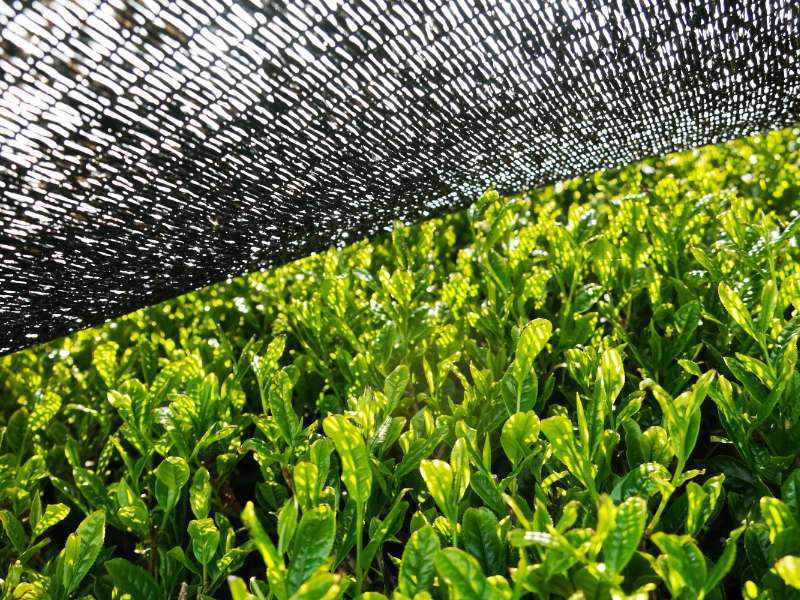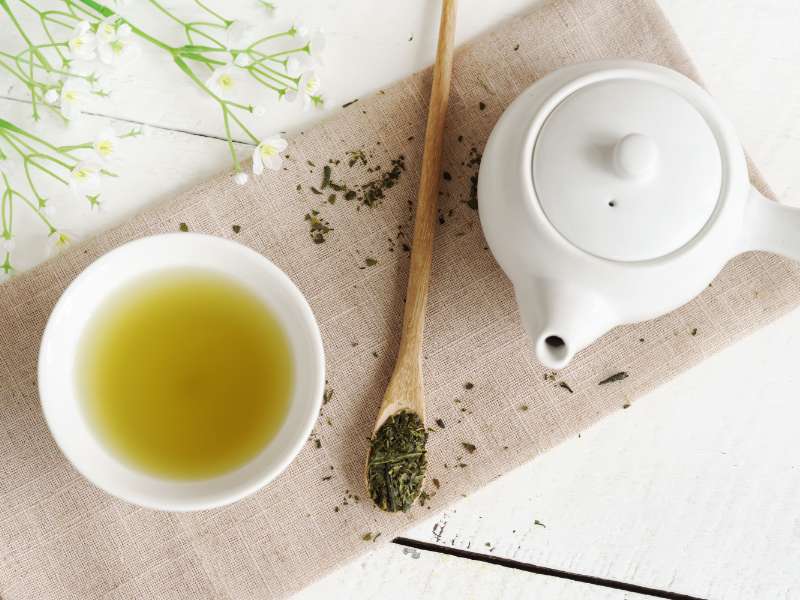The most important things at a glance
-
Green tea has a long history and many different varieties, with origin, time of harvest and processing methods such as steaming (Japan) or heating (China) being crucial for taste and quality.
-
In addition to its rich flavor, green tea is valued for its health benefits due to its antioxidants and vitamins.
-
To enjoy green tea optimally, it is important to prepare it correctly with the right water temperature and brewing time, as well as to use suitable accessories such as Kyusu teapots and large tea strainers.
Discover the world of green tea

Green tea, a staple of cultures in Japan and China, is loved worldwide for its fresh taste. Its diversity is staggering, with countless varieties derived from the two main species of tea plant, Thea assamica and Thea sinensis. From Sencha to Genmaicha, each variety of Japanese green tea has its own identity and flavor that makes it unique.
When buying green tea, you should find out about its origin, the tea leaves used and how the tea was grown and processed. Knowing these factors will help you better judge the quality of the tea and enrich your tea experience.
Green Tea: Origin and History
The origins of green tea date back over 4,000 years to China, where the tea plant has been cultivated since the 6th century BC. Buddhist monks brought green tea to Japan in 805 AD, which had a significant impact on the development of Japanese tea culture.
Green tea was first cultivated in Japan by heating the leaves after harvesting to prevent fermentation, a method that originated in China in the 8th century. In the 16th and 17th centuries, green tea reached Europe and began to spread throughout the Western world.
This rich history has greatly shaped the heritage and presence of green tea in the world today.
Health Benefits of Green Tea
Aside from its rich flavor and deep-rooted history, green tea is also known for its numerous health benefits. Traditionally, green tea has been valued in Chinese medicine for its antioxidant properties and beneficial effects on the cardiovascular system. In fact, regular consumption of green tea can reduce the risk of cardiovascular disease.
Green tea contains epigallocatechin gallate (EGCG), a powerful antioxidant that can protect the immune system. Green tea is also a source of vitamin C and zinc, which support the immune system. It also contains amino acids, chlorophyll, and minerals, all of which are beneficial to health. However, with all these health benefits, it is important to note that excessive consumption of green tea, especially more than 10 cups per day, can cause negative health effects such as liver damage.
The Art of Green Tea Production

Did you know that the way green tea is made varies greatly and has a significant impact on its taste and quality? Yes, making green tea is an art that requires careful precision and knowledge.
In Japan, the tea leaves are exposed to steam for about two minutes, while in China, the leaves are heated in hot drums, pans or pots. These different methods lead to the diverse flavor profiles we find in different types of green tea. For example, the Chinese methods can produce different flavor profiles in green tea through different degrees of roasting.
Furthermore, the time of harvest significantly influences the quality of the green tea, with the first flush in spring being considered to be of particularly high quality.
Chinese green tea production

Green tea from China is known for its high quality and rich variety. The “Ming Qian” tea, which is harvested before the Qingming Festival, is particularly prized. The quality of green tea is also categorized according to the temporal context of the harvest - “Yu Qian” before and “Guyu Cha” after the Guyu rain.
Chinese methods of processing green tea are as varied as their tea varieties. Freshly harvested tea leaves are dried quickly to prevent oxidation. This can be done by drying in pans or woks, or over charcoal. Certain green teas from China, such as Longjing, are carefully hand-shaped after roasting, giving them a recognizable flat shape.
Japanese green tea production

In Japan, on the other hand, the processing of green tea is characterized by treating the leaves with steam to prevent oxidation. You may have noticed that Sencha, the most commonly consumed green tea in Japan, has a characteristic needle-like shape. This is the result of rolling the tea leaves on special machines after steaming.
Japanese production also creates unique green teas such as Hojicha, which is roasted over charcoal and offers a fine roasted aroma with nuances of nuts, caramel and malty sweet flavors. Bancha is also particularly popular, an extremely drinkable and refreshing tea that is drunk on all occasions in Japan.
Popular Green Tea Varieties and Their Flavor Profiles

Besides all these facts and information, what really matters is the taste and experience that the tea offers. There is a wide range of popular and aromatic green teas, which mainly include Sencha and Matcha.
Sencha, the most commonly consumed green tea in Japan, is made by briefly steaming the tea leaves and is known for its refreshing and slightly grassy taste. Matcha, on the other hand, is a finely ground green tea powder, rich in amino acids and chlorophyll, and offers a distinctive umami taste coupled with health benefits.
organic quality and sustainable cultivation
If you want to buy green tea, it is also important to pay attention to the following points:
-
Organic quality: Organic products are produced in accordance with EU legislation on organic farming, which requires organic production and animal welfare.
-
Sustainable cultivation: Make sure that the green tea is grown sustainably to protect the environment.
-
EU organic logo: Consumers in the EU can find the EU organic logo on pre-packaged organic foods. This logo is ensured by detailed records and controls by private and government bodies.
By keeping these points in mind, you can ensure that you are buying high-quality and environmentally friendly green tea.
In addition, direct trade in tea improves the living and working conditions of tea farmers and helps prevent child labor, while reducing the risk of pesticide exposure for consumers. Sustainable tea traders buy tea directly from small farmers without middlemen to create social and economic benefits for local communities.
How to enjoy green tea properly
Now that we've explored the world of green tea, it's time to enjoy a cup yourself! For an aromatic green tea infusion, the right dosage, water temperature and brewing time are crucial, and the tea leaves need enough space to expand.
Green tea should be prepared as follows:
-
The brewing time should be 1 1/2 to 2 minutes to avoid bitterness. The exact brewing time can vary depending on the quality of the tea.
-
Green tea should not be brewed with boiling hot water. The ideal water temperature is between 60° and 80° C.
-
Incorrect preparation, such as too high a temperature or too long a brewing time, can lead to a bitter or fishy taste.
green tea accessories
To optimize your tea enjoyment, you can use various accessories. Kyusu teapots from Japan are particularly suitable for preparing green tea as they have an integrated tea strainer, enhancing the flavor of the tea and giving it room to breathe. Teapots should be made of natural material such as clay and not made of uncoated metals to maximize their health benefits.
In addition to teapots, stainless steel tea strainers are also a good alternative to ceramic strainers. They should be large enough to give the tea leaves room to unfold. Large mesh sizes of the tea strainers are important to retain healthy suspended particles in the tea, and tea eggs are not recommended for high-quality green tea.
Transparent tea glasses with a stainless steel tea strainer are a practical alternative for enjoying green tea while travelling. Visit our online tea shop for more information and products related to tea.
Exotic green tea blends
To conclude our journey into the world of green tea, we would like to introduce you to some exotic green tea blends. These blends, influenced by local culture, reflect the importance of tea in social gatherings and hospitality in different parts of the world. Each green tea blend has its own unique flavors.
From Moroccan Peppermint to South African Rooibos Green Tea Blend, from English Country Garden Blend to Aztec Turmeric Blend from Mexico, each of these blends offers a unique taste experience that transports them to different places in the world. Whether you're looking for a hint of spice or a burst of freshness, there's an exotic green tea blend that will delight your palate.
Summary
From its rich history and diverse varieties to its health benefits and the art of tea brewing, the world of green tea holds a fascination that goes far beyond a simple cup of tea. Every cup of green tea you enjoy is a tribute to thousands of years of tradition, carefully preserved methods, and the hard work of tea farmers. So, the next time you drink a cup of green tea, take a moment to appreciate the heritage, culture, and art contained in each cup.
Frequently Asked Questions
What is green tea good for?
Green tea is healthy because it contains valuable flavonoids and amino acids. These have a positive effect on protection against various diseases, reduce the risk of heart attack, stroke and high blood pressure and have a protective effect on the immune system.
Is drinking green tea every day healthy?
Yes, 3-4 cups of green tea daily is healthy, but do not drink more than 10 cups as it may affect your health.
How much green tea can you drink per day?
You should drink about 3-4 cups of green tea per day to benefit from its healthy properties. It is recommended not to drink more than 10 cups per day as it can be detrimental to your health.
When is the best time to drink green tea?
It is best to drink green tea some time after a meal, i.e. on a full stomach, to avoid irritation of the stomach lining.


